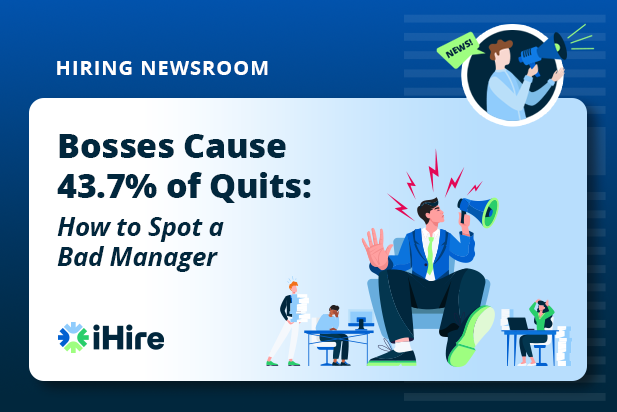- Employer Resources
- |
- Last Updated: February 06, 2024

Bosses Cause 43.7% of Quits: How to Spot a Bad Manager
The Great Resignation showed no signs of slowing down in 2022, as 41.2% of workers voluntarily left their job in the past year, according to our Talent Retention Report. Among the employees who stepped away from their posts, 43.4% did so because of unsatisfactory pay. However, the largest catalyst for employees racing for the exits wasn’t their paychecks but their supervisor.
43.7% of surveyed workers vacated their roles because they were unhappy with their manager. Poor management can destroy an organization’s culture and make it hard to build a good working environment. In addition to the obvious drain on retaining valuable employees, it tanks workplace engagement and leads to quiet quitting, as a Gallup poll showed that only 21% of workers felt their performance was managed in a way that motivates them to do outstanding work. The stress that a bad supervisor provides can also cause physical harm to their reports.
If your employees are less engaged with their work than they used to be, here’s how to identify a bad manager draining your energy at the office:

They Constantly Micromanage Employees
Micromanaging is one of the most telltale signs of a bad manager. Employees getting scrutinized for every task they complete makes them feel untrustworthy. It’s a fast way to make workers question their value to a company or, even worse, send them out the door.
They Are Quick to Take the Credit
Picture this: You task a manager and their team with working on an important project in collaboration. After weeks (or months) of collaboration, the manager nails all the details and presents the project, while soaking up all the praise that should be shared with their direct reports. Managers taking credit for their employees’ output undermine their teams’ hard work and sabotage their chances of moving up in the organization when their best efforts go unnoticed by upper management.
Find Excellent Management Candidates Today
And Even Quicker to Place the Blame
A bad manager has never heard the phrase, “When you point one finger, three fingers are pointing back at you.” A survival mechanism for a flawed supervisor is when something goes wrong, blame someone else. A manager who deflects blame is trying to elevate themselves above their subordinates, and that behavior breeds incalculable resentment from workers. Even if an employee makes a mistake, such discussions should occur behind closed doors.

They Don’t Communicate Clearly (or at All)
Communication is crucial to every strong relationship, including between a worker and their supervisor. An effective manager guides their direct reports and checks in on each team member regularly. These status updates frequently come in the form of scheduled one-on-one meetings where they can answer questions directly and provide concrete goals employees should be working towards.
One of the signs of a bad manager is that they aren’t available to address questions, and even when they provide instruction, it is so vague that it leaves workers guessing about their day-to-day expectations. Employees who spoke with their managers about their goals and successes within the past six months were 2.8 times more likely to be engaged in their work, according to Gallup.
They Don’t Value Feedback
A poor manager bristles at the thought of feedback from their employees. In meetings, they expect workers to follow their marching orders (clear or otherwise) without question. Offering a contrary viewpoint is taken as a threat undermining their authority instead of an alternative way of solving a problem or completing a project. If your supervisor’s response to feedback in either a group or one-on-one setting is defensive, that is a clear sign that they are more interested in dictating than collaborating.
Check out our resource center for more information on employee engagement and retention. Also, explore our customizable HR Services and Consulting services to further improve your company’s culture through management training and employee communication.

November 21, 2022




